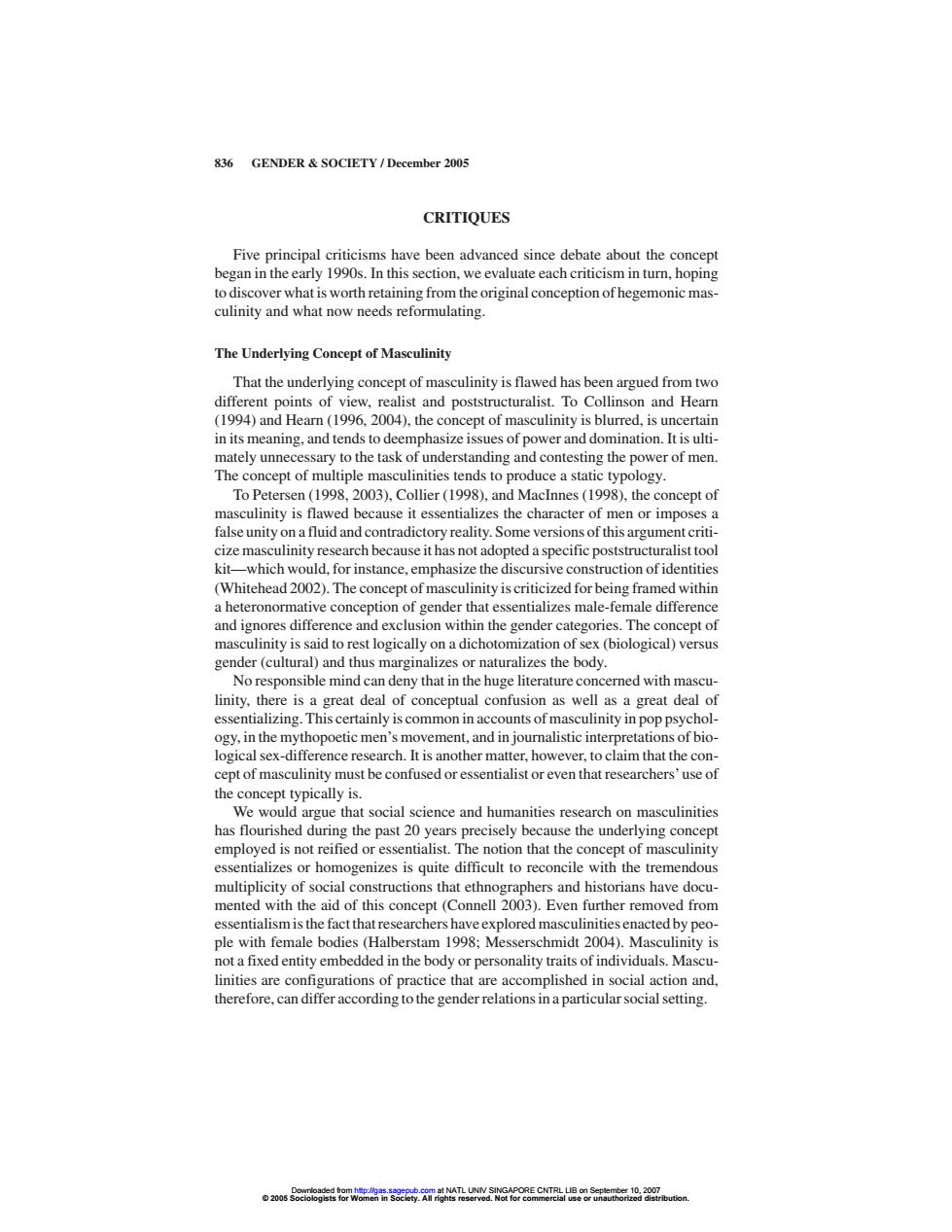正在加载图片...

836 GENDER SOCIETY/December 2005 CRITIQUES Five principal criticisms have been advanced since debate about the concept began in the early 1990s.In this section,we evaluate each criticism in turn,hoping to discover what is worth retaining from the original conception of hegemonic mas- culinity and what now needs reformulating. The Underlying Concept of Masculinity That the underlying concept of masculinity is flawed has been argued from two different points of view,realist and poststructuralist.To Collinson and Hearn (1994)and Hearn (1996.2004),the concept of masculinity is blurred,is uncertain in its meaning,and tends to deemphasize issues of power and domination.It is ulti- mately unnecessary to the task of understanding and contesting the power of men. The concept of multiple masculinities tends to produce a static typology. To Petersen(1998,2003),Collier(1998),and MacInnes(1998),the concept of masculinity is flawed because it essentializes the character of men or imposes a false unity on a fluid and contradictory reality.Some versions of this argument criti- cize masculinity research because it has not adopted a specific poststructuralist tool kit-which would,for instance,emphasize the discursive construction of identities (Whitehead 2002).The concept of masculinity is criticized for being framed within a heteronormative conception of gender that essentializes male-female difference and ignores difference and exclusion within the gender categories.The concept of masculinity is said to rest logically on a dichotomization of sex(biological)versus gender(cultural)and thus marginalizes or naturalizes the body. No responsible mind can deny that in the huge literature concerned with mascu- linity,there is a great deal of conceptual confusion as well as a great deal of essentializing.This certainly is common in accounts of masculinity in pop psychol- ogy,in the mythopoetic men's movement,and in journalistic interpretations of bio- logical sex-difference research.It is another matter,however.to claim that the con- cept of masculinity must be confused or essentialist or even that researchers'use of the concept typically is. We would argue that social science and humanities research on masculinities has flourished during the past 20 years precisely because the underlying concept employed is not reified or essentialist.The notion that the concept of masculinity essentializes or homogenizes is quite difficult to reconcile with the tremendous multiplicity of social constructions that ethnographers and historians have docu- mented with the aid of this concept(Connell 2003).Even further removed from essentialism is the fact that researchers have explored masculinities enacted by peo- ple with female bodies (Halberstam 1998;Messerschmidt 2004).Masculinity is not a fixed entity embedded in the body or personality traits of individuals.Mascu- linities are configurations of practice that are accomplished in social action and, therefore,can differ according to the gender relations in a particular social setting. o2oosS6e08a8rmh8Pg532RT4T6066O2ECTBgarto1827butionCRITIQUES Five principal criticisms have been advanced since debate about the concept began in the early 1990s. In this section, we evaluate each criticism in turn, hoping to discover what is worth retaining from the original conception of hegemonic masculinity and what now needs reformulating. The Underlying Concept of Masculinity That the underlying concept of masculinity is flawed has been argued from two different points of view, realist and poststructuralist. To Collinson and Hearn (1994) and Hearn (1996, 2004), the concept of masculinity is blurred, is uncertain in its meaning, and tends to deemphasize issues of power and domination. It is ultimately unnecessary to the task of understanding and contesting the power of men. The concept of multiple masculinities tends to produce a static typology. To Petersen (1998, 2003), Collier (1998), and MacInnes (1998), the concept of masculinity is flawed because it essentializes the character of men or imposes a false unity on a fluid and contradictory reality. Some versions of this argument criticize masculinity research because it has not adopted a specific poststructuralist tool kit—which would, for instance, emphasize the discursive construction of identities (Whitehead 2002). The concept of masculinity is criticized for being framed within a heteronormative conception of gender that essentializes male-female difference and ignores difference and exclusion within the gender categories. The concept of masculinity is said to rest logically on a dichotomization of sex (biological) versus gender (cultural) and thus marginalizes or naturalizes the body. No responsible mind can deny that in the huge literature concerned with masculinity, there is a great deal of conceptual confusion as well as a great deal of essentializing. This certainly is common in accounts of masculinity in pop psychology, in the mythopoetic men’s movement, and in journalistic interpretations of biological sex-difference research. It is another matter, however, to claim that the concept of masculinity must be confused or essentialist or even that researchers’use of the concept typically is. We would argue that social science and humanities research on masculinities has flourished during the past 20 years precisely because the underlying concept employed is not reified or essentialist. The notion that the concept of masculinity essentializes or homogenizes is quite difficult to reconcile with the tremendous multiplicity of social constructions that ethnographers and historians have documented with the aid of this concept (Connell 2003). Even further removed from essentialism is the fact that researchers have explored masculinities enacted by people with female bodies (Halberstam 1998; Messerschmidt 2004). Masculinity is not a fixed entity embedded in the body or personality traits of individuals. Masculinities are configurations of practice that are accomplished in social action and, therefore, can differ according to the gender relations in a particular social setting. 836 GENDER & SOCIETY / December 2005 © 2005 Sociologists for Women in Society. All rights reserved. Not for commercial use or unauthorized distribution. Downloaded from http://gas.sagepub.com at NATL UNIV SINGAPORE CNTRL LIB on September 10, 2007